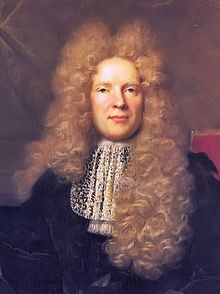wig


Wigs (in the 17th century borrowed from the French peruque "head of hair"), originally made from real human hair, imitate a natural head of hair, traditional or fashionable hairdresses . They are worn according to traditional customs or rites, but are also fashionably made especially for those who wear them if they are hairless.
They serve as a second hairstyle that is intended to replace or complement the actual natural hair. In the theater and in the film industry, wigs, mostly real hair wigs, are used for costumes .
history
Wigs were already worn equally by men and women in ancient Egypt . Even in ancient Greece and the Roman Empire , women wore wigs or extensive hair pieces.
In the early baroque era , the wig came back into fashion. Above all, it served to conceal the disease-related hair loss in syphilis , alopecia syphilitica and the consequences of treatment with mercury . The wig also has a warming effect, which was another advantage in the baroque castles that were difficult to heat. In 1656 the first guild for wig makers was established in Paris. When Louis XIV resorted to a wig because of his thinning hair - previously it was only worn by courtiers and bald people - the allonge wig became an important symbol and attribute of court clothing for men in Europe.
After 1700 white powdered wigs with mostly horizontally arranged curls appeared. They were mainly made from horse or goat hair as well as hemp and flax . A wig tax was levied in Prussia from 1698 to 1717 . Soldiers and travelers wore shorter models, so-called short wigs, farmers and craftsmen did not wear any. Powdering of wigs was generally forbidden for the lower classes and was subject to a tax.
Even before the French Revolution came the end of the wig fashion. Since then, wigs and toupees have only been worn by men as part of official costumes in the administration of justice or for medical reasons. For the ornate women's hairstyles in Biedermeier , often only hairpieces were used.
Except for brief fads in parts of society (e.g. 1960s ), wigs have never become fashionable again.
The Jewish law requires married, divorced or widowed women hide their hair. Therefore, especially ultra-orthodox Jewish women of the Ashkenazim, for fashion reasons, wear a wig instead of a different headgear, called parting in Yiddish (also known as Schaitel; שייטל YIVO sheytl m.sg.,שייטלעך YIVO sheytlekh m.pl. orשייטלען YIVO sheytlen m.pl.). Sephardim are not allowed to do this. The Sephardic Rabbi Ovadja Josef has forbidden this because they look like real hair and can still give the man immoral thoughts.
Manufacturing
Wigs can be made from artificial or real hair. Real hair often came from people from poorer countries and areas who made some money selling their own hair. Today, most of human hair comes from India and China . Basically, because of its genetic structure, Indian hair is particularly suitable for wigs with “European” hairstyles. However, Chinese hair is also often added, as it is easier to process into lighter shades of color (blonde tones). Chinese hair is structurally similar to African hair, which is particularly evident in the thickness of the hair. This makes it easier for it to absorb the new color pigments after decolorization.
In India, human hair is usually obtained through traditional rituals, in which women sacrifice their hair in temples according to ancient Hindu customs. The temples then sell the hair on in large auctions , with two thirds of the proceeds going to charities, monitored by the state. Due to the high demand for the raw material "real hair", it is now one of the most expensive raw materials in the world at up to 600 USD per kilogram.
The hair is washed, sorted by length, curled and colored. To do this, the fiber is first decolorized in osmosis baths and then filled with new color pigments in the cavities that have been created. The outer cuticle is also often removed to prevent felting.
You can also differentiate between different hair qualities. Untreated hair is important for further processing. This is also one of the reasons why hair from Central Europe is almost never used for wig processing, as the hair structures are attacked by various shampoos , care products and dyes. Another quality criterion is the same direction of growth and thus the same orientation of the cuticle. Therefore, cut braids and strands are very useful for further processing - in contrast to “swept up” hair.
In the further course of the process, strands of hair of different color nuances are combined into a wig in order to achieve the most natural look possible. Most of this is done by hand, which ultimately means that the price of a wig also reflects its manufacturing effort.
A 60 cm long women's wig weighs approx. 150 g.
Processing types
The processing types begin with the so-called gear. The wig mount is the part that the hair is attached to. The quality of the wig and the wearing comfort also differs through the type of mount.
- Weft : The hair is machine sewn onto thin strings, the wefts. The braids are attached to cotton ribbons that form the basic shape. The weft wig adapts well to the shape of the head.
- Mono-parts with a dividing monofilament wig is a part, usually the upper head of the wig from monofilament , a skin-like tissue. It is also possible to provide the area of the vertex or vertebra with the tissue. The hair is then worked into this fabric by hand. The rest of the kit is designed as a braid.
- 100% Hand-knotted : The gear consists of a fine tulle fabric , the Haartüll . The hair is pulled individually through the fabric and knotted by hand.
- Film approach : The kit consists of monofilament and a transparent edge strip, the so-called film strip. The hair is worked into the film strip by hand. The edge strip ensures a particularly natural look.
Wig heads
Wig heads, also known as hood sticks in Austria , were used as early as the Baroque and Rococo for custom-made wigs and for storing them. Bonnets were almost always made of - occasionally painted - wood and had the shape of a head with a bust. Some examples from France and Venice are tasteful works of art by sculptors. French wig makers used hood sticks with wigs to advertise their products. Some wig stands were made of porcelain, in this case they were spherical with a stand and were only used to store the wig.
present
Nowadays, wigs are usually made and worn in such a way that they appear to have grown. In everyday life, wigs are usually worn for aesthetic reasons, for example in the case of hair loss as a result of chemotherapy . Women today also use wigs to have a perfect hairstyle in a short time and / or to give their little hair a larger volume. Wigs are also used in the theater, and more unusual wigs (such as afro look or mullet ) are also often used at carnival events.
Wigs are also made from synthetic hair. A widely used material is e.g. B. Kanekalon . Theatrical wigs are partly knotted on monofilament-fine tulle, which can no longer be seen from a short distance, while looking through the "scalp" creates a very natural look.
Real hair or synthetic hair is a question of demands. While wigs made from real hair are often worn with the aim of being as authentic as possible, a synthetic hair wig tends to meet the need for an easy-care "second hairstyle". Human hair wigs are characterized by their durability and natural properties. They can be colored, smoothed or curled and cut individually. A wig made of synthetic hair is available in different quality classes. With cheap synthetic hair wigs, the hairstyles are more or less fixed and can hardly be changed. A higher quality class is z. B. Futura synthetic hair, which can be changed with a little effort and comes closest to real hair. Ultimately, the style and quality of the hair depend on the price.
literature
- Luigi Amara : The wig . Translation from the Spanish by Peter Kultzen. Berlin: Berenberg, 2017 ISBN 978-3-946334-15-6
- Jochen Luckhardt (ed.): Splendor of curls and ruling power. Wigs as a status symbol and fashion accessory . Volume accompanying the exhibition in the Herzog-Anton-Ulrich-Museum Braunschweig 2006. Koehler and Amelang, Leipzig 2006, ISBN 3-7338-0344-2
- Heinrich Meyer zu Ermgassen (Ed.): "How I arrived in Marburg ...". The life and family history of the Marburg wig maker Johannes Kuntz (1760–1831) written by himself . (= Marburg town writings on history and culture; Vol. 75). Rathaus-Verlag, Marburg 2003, ISBN 3-923820-75-5
- Susanna Stolz: The handicrafts of the body. Bader, barber, wig maker, hairdresser. Consequence and expression of historical understanding of the body . Jonas, Marburg 1992, ISBN 3-89445-133-5 (also dissertation, University of Marburg 1992)
See also
Web links
Individual evidence
- ↑ J. Caspary: About chronic mercury treatment of syphilis. (PDF) In: Vierteljahresschrift für Dermatologie und Syphilis , 1887, Volume 19, Issue 1, pp. 3–35
- ↑ To die before dawn . In: Der Spiegel . No. 40 , 1985 ( online ). It was not for nothing that the Allonge wig came into fashion at court, with which syphilis-related hair loss could be perfectly concealed. "You can see so many people being shaved," scoffed a contemporary, "and without any razors."
- ↑ Gabriel Miller: Orthodox and Ultra-Orthodox Jews. In: Ask the Rabbi. Retrieved August 26, 2016 : "Married women of the ultra-Orthodox cover their hair with a wig out of chastity, while Orthodox women only cover their hair with a cap or hat."
- ↑ Lea Hampel: Victoria's head. Many Orthodox women follow tradition - and trends. In: Jüdische Allgemeine. March 11, 2010, retrieved on August 26, 2016 : “Which wig a woman chooses depends on the direction of Judaism she follows. As a rule, wigs are mainly worn by Ashkenazim. "
- ↑ Oren Geller: Orthodox Jews follow strict rules - also externally. What sidelocks, kippahs and hats mean. Why does it look like this? In: Berliner Zeitung , May 22, 2009. “And Racheli, an Orthodox Jew from an Ashkenazi movement, can choose whether she wears a scarf or a wig, for example. 'Women of the Sephardic currents are not allowed to do that,' she says. The leading clergyman of the Sephardi, Rabbi Owadja Jossef, has banned toupees because they look like real hair and can still give the man immoral thoughts. "


